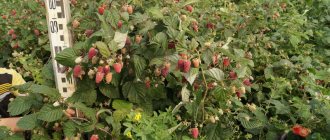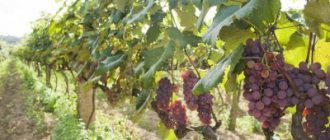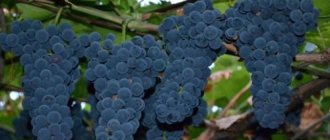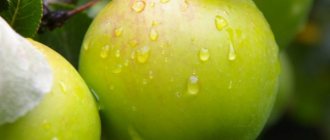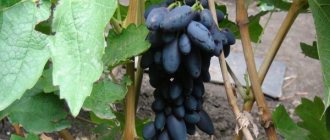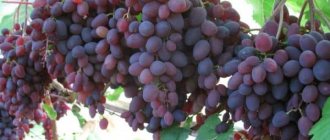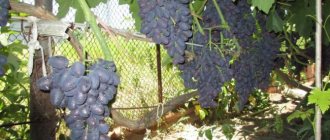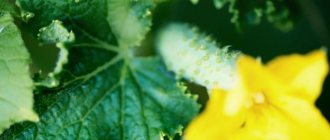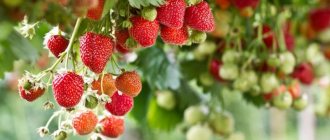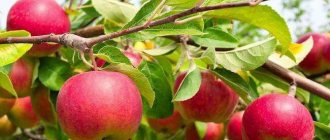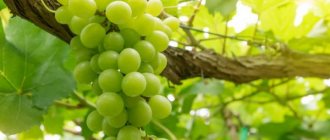Advantages and disadvantages
When deciding to grow “Beauty of the North” grapes on your plot, you should first become familiar with its advantages and disadvantages.
Among the advantages of the variety, confirmed by the long period of its cultivation in Russia, are:
- stable and high productivity;
- pleasant taste and versatility of using berries;
- early ripening;
- frost resistance;
- sufficiently long storage and good transportability.
In addition, the “beauty of the north” does not have any special care requirements, and the fruits are not prone to cracking even under conditions of high humidity.
This variety has practically no disadvantages. Only its tendency to be attacked by insects and low disease resistance are noted.
Krasa Severa grapes – stages of cultivation from planting to harvesting + video
Preface
Few fruit-bearing crops are able to grow in areas with frosty winters, but Krasa Severa grapes are resistant to cold and can withstand low temperatures up to a certain limit without shelter. Next we will talk in detail about this variety.
Yes, Olga is the second name of the Beauty of the North, and today, 56 years after the registration of this variety, no exact information has been preserved about where the synonym similar to the human name came from. However, the parents of this form are reliably known - they became Taifi Rozoviy and Zarya Severa, with the participation of breeders from the Michurin Horticulture Research Institute. Then the variety quickly became quite popular and became widespread both in Russian nurseries and in private vineyards. The main criterion for choosing Olga by many gardeners was the fact that her bushes are capable of successfully developing in rather unfavorable conditions, which relate to both climate and soil.
Grape variety "Krasa Sevara"
The Krasa Severa bushes are distinguished by their tall growth, the vine is often quite long, and all shoots ripen well during the growing season, which allows them to withstand harsh winters down to -26 degrees without damage. The clusters of this grape are quite large, up to 900 grams, conical in shape, somewhat loose. The berries are also large, their average size is 21x19 millimeters, that is, the shape is round, but slightly elongated. Their ripening lasts approximately 110 days. Provided that the total temperature during the warm season is about 2200 degrees, ripeness is reached in mid-August.
Fruits, the quantity and quality of which are the goal when planting a vineyard, should be considered separately. So, we have already mentioned the size of the berries above, but their weight often reaches 5 grams. The skin is quite thin, easy to eat, the flesh is juicy, somewhat fleshy, without looseness, but spreads easily. The aroma is almost not felt, the taste is simple, without any signs of nutmeg. Sugar content is within 17%, that is, not too high, while acidity reaches 5.4%. Gardeners have noted that the fruits of the Beauty of the North crack during rainy seasons, but with abundant soil moisture they can remain on the bush for quite a long time after ripening if the bunches are covered from precipitation.
Planting vines - useful information from experts
First of all, it should be remembered that in order to obtain the Olga variety, a frost-resistant variety, namely Zarya Severa, was chosen as one of the parent forms. Accordingly, the result of crossing was also winter-hardy. Therefore, when planting, you don’t have to try to choose a place protected from the winds. The main thing is not to make a mistake with the choice of soil. It is better if it is sandy loam, or even sand-dominated soil. Be sure to allocate 6 square meters for each bush; this is necessary so that the plant receives enough nutrients without having to share them with neighboring individuals. That is, for each row you need to determine a width of 2 meters, and leave a gap of 3 meters between plantings.
Olga has not yet been sufficiently tested for the compatibility of the eye with the rootstock, so propagation by cuttings is usually used. The planting method is standard for any grape variety, that is, a hole more than 50 centimeters deep is dug, and humus mixed with sand is placed at the bottom. Next, we place a pre-sprouted cutting there and dig it in with soil taken from the depths. The root collar should remain approximately 5 centimeters above the surface. Next, when the shoots appear, we select the 4 strongest ones and cut off the rest to ultimately get 4 vines, which should be attached to trellises for the vineyard in a fan pattern.
Planting grapes
Next, you need to provide the plants with proper care. Fruiting will occur only after 2–3 years, and therefore first you need to
You can only form bushes by cutting off part of the shoots. Over time, when productive shoots appear, they will need to be trimmed into 8–10 eyes, some of which will become tassels. However, in order not to overload the bush, you can reduce the number of eyes to 6 by pruning, since the appearance of an excessive number of bunches most often leads to a decrease in the size of the berries. When forming clusters, it is recommended to standardize, leaving at least one on each shoot or no more than 40 on each bush.
Preparation for winter involves removing the sleeves from the support and covering them with a special film. The Krasa Severa grape variety does not need to be insulated unless very severe and prolonged frosts are expected, but be sure to monitor the weather forecasts.
The fight for Olga’s health – prevention and treatment
In early spring, it is necessary to begin preventive measures to prevent the appearance of mildew and oidium outbreaks in the vineyard. The first treatment against diseases should be carried out at the very beginning of the season, when the plant enters the active growth phase. For mildew, it is best to use Bordeaux mixture or, as a last resort, diluted copper sulfate; many gardeners also use cuprostat. In the fight against oidium, you need to use colloidal sulfur or a special drug, for example, Topaz. It is imperative to spray the Beauty of the North a second time after the leaves appear, since it is during this period that it will be clear whether one of the above diseases has occurred on the vine.
It is also necessary to carry out pest control treatment in a timely manner. The greatest damage to vineyards is always caused by phylloxera, which requires treatment with karbofos or BI-58 at the stage of seedling preparation. However, already rooted plants also require prevention, for which they are sprayed with special insecticidal preparations after bud break when the first 2-3 leaves form on the shoots. The treatment should be repeated after the formation of 9–12 leaves on each shoot. However, in cold regions located north of central Russia, the appearance of phylloxera in a vineyard is unlikely.
Protecting grapes from pests
Often the harvest of the Beauty of the North is threatened by the cluster leaf roller, whose butterflies lay eggs in the buds, as well as in the calyxes of flowers during the active flowering phase. Subsequently, the emerging caterpillars begin to eat the ovaries or the ridges of the developing bunches. However, this is not all. Soon the caterpillars pupate and manage to turn into butterflies, and then lay eggs on the already formed brushes. The next offspring spoils the green berries, and the third generation manages to feast on the remnants of the harvest, and already at the ripening stage. Treatment with special insecticides at the stage of bud formation can help, which should be repeated immediately before flowering begins. In the future, you need to spray every 2-3 weeks during the formation of clusters.
And finally, one cannot fail to mention the constant threat to grape berries from wasps and hornets, which love to feast on already ripened fruits. It is enough to be late with preventive measures by 1 day to lose most of the fruits, which will be hopelessly spoiled. First of all, it is recommended to hide the bunches in gauze bags, which will become a fairly reliable obstacle to insects. However, it is better to hang wasp traps on the vineyard supports in advance, for which ordinary bottles are used, at the bottom of which a pleasant-smelling syrup mixed with insecticides is poured. It is also necessary to promptly identify nests of wasps and hornets and destroy them.
- Author: Publer Ksenia L
nasotke.ru
Origin
The “Beauty of the North” grapes were bred in 1960 by scientists from the VNIIS named after. Michurin as a result of breeding work, during which the varieties “Zarya Severa” and “Taifi Pink” were crossed.
Parents of “Beauty of the North” – “Dawn of the North” and “Taifi Pink”
Among gardeners, this variety is often called “Olga” - this is the name that I.M.’s wife gave to the new variety of grapes, in honor of their daughter. Filippenko and I.L. Shtin, but later the variety received a second, official name “beauty of the north”. It is also worth learning about such early table varieties as “Trumph”, “Sofia” and “Aleshenkin”.
Reference! The variety has been under variety testing since 1977 and was included in the State Register of Agricultural Achievements in 1994.
Landing
Even a novice winegrower can plant the Beauty of the North on his plot, following simple rules:
- It is necessary to choose the right place for planting seedlings. A well-lit, dry, elevated area, protected from strong winds, is suitable;
- the variety grows well on sandstones and sandstones, where the distance of groundwater from the soil surface is at least 2.5 meters;
- The area for grapes is dug up in advance, all weeds and roots are removed. Then fertilizers, organic matter and mineral complexes are added;
- two weeks before planting, prepare holes 60 x 60, at a distance of 2 m from each other. If there are a lot of bushes, then make the distance between the rows 3 m;
- drainage is placed at the bottom of the holes, then a mixture of the upper fertile layer with humus and compost is placed so that a mound is formed;
- a seedling is placed on this mound, the roots properly straightened, and covered with the remaining soil;
- then, the soil around the seedling is compacted, watered with 2 buckets of water and covered with mulch - peat, humus or rotted manure.
The optimal time for planting seedlings is spring, when the soil is well warmed up, or autumn, when severe cold has not yet set in.
Main characteristics
“Beauty of the North” is a white table grape variety, the berries of which are suitable both for fresh consumption and for processing and making juices, jams or wine.
Maturation period and class
The “Beauty of the North” grapes are an early ripening variety with a growing season of 110-115 days. The berries begin to ripen en masse already in mid-August, and the harvest takes place at the end of the month.
Bush
“Beauty of the North” are vigorous and spreading bushes that can grow up to 3 m in height in just a year. The leaf blades are large, five-lobed, weakly dissected, painted light green, with a thin glossy coating on the outside and slight pubescence on the inside.
The flowering period begins in May and lasts approximately 10 days. At this time, small bisexual white flowers appear on the bushes, collected in racemes.
Bunches and berries
The clusters are usually loose, quite rarely medium-dense, have a conical or branched shape and weigh on average 250-500 g. The berries are round or oval-round in shape, large - reach 2 cm in length and width and weigh 4-5 g, covered with a thin , but with a durable skin of a white-greenish color with a tan pink hue, on which there is a thin layer of waxy coating. The pulp is fleshy and juicy, with 2-4 small seeds inside.
The sugar content of the fruit reaches 14-17%, and the acid content is 5.4 g/l.
Taste and yield
The taste of the fruit is simple but pleasant. The berries have a slight tartness and herbaceous flavor.
The bushes begin to bear fruit 3 years after planting. The yield is plentiful - up to 12 kg of berries can be collected from 1 bush.
Grape variety “Lyana”
Lyana
Bred by breeders of the Chisinau Agricultural Institute and the Moldavian Scientific Research Institute of Vierul and Vierul by crossing the varieties Chaush white and Pierril (Save Villar 20-366) with subsequent selection against an infectious background. A table variety with a medium ripening period, that is, it ripens almost simultaneously with the white Chasselas variety. The duration of the period from bud break to grape ripeness is 135 days at a sum of active temperatures of +2450 °C. Productivity is within 120-150 c/ha. The average weight of a bunch is 215 grams. The variety is quite frost-resistant, increased resistance to mildew (virtually does not require spraying), anthracnose, and oidium (2 points). Resistance to phylloxera and gray rot 3 points. The bushes develop well on the rootstocks Berlandieri x Riparia Kobera 5BB, C04, Riparia x Rupestris 101-14. Pruning shoots into 6-9 buds, a load of 40-50 buds per bush. As a variety with group resistance, fairly high indicators of taste, elegant bunches and berries, it should be tested in all natural regions of Donbass, and in the southern regions - with a high-standard culture.
Comparison with analogues
Let’s compare the “Beauty of the North” grapes with similar varieties:
| Sign | Variety | ||||
| Beauty of the North | Agate Donskoy | Chrysolite | Charlie | Julian | |
| Ripening period | 110-115 days | 115-120 days | 125-130 days | 105-115 days | 100 days |
| Frost resistance | Up to -26 °C | Up to -26 °C | Up to -25 °C | Up to -24-25 °C | Up to -23 °C |
| Yield per bush | Up to 12 kg | Up to 50 kg | 30 kg | 15-20 kg | 30-60 kg |
| Bunches | 250-500g | 400-600 g | 600 g | 700-900 g | 800-1200 g |
| Taste | Tart with herbaceous flavor | Simple and harmonious | Nutmeg with hints of fruit | Tart taste of nightshade | Notes of nutmeg and strawberry |
| Color | White-green with a pink tint | Dark blue or violet red | Green-yellow with amber tint | Dark blue | Light pink |
| Disease resistance | Average | High | Average | Average | High |
| Shelf life | A few months | 2-3 weeks | 3-4 weeks | A few months | 1-2 months |
| Sugar content | 14-17% | 13-15% | 17,3% | 18-22% | 28% |
| Acidity | 8-9 g/l | 6-7 g/l | 6.1 g/l | 4-7 g/l | Not installed |
Work order
A planting hole measuring 80-90 cm is prepared for the grapes. Then it is left for 3-4 weeks for the soil to settle.
Sequence of planting grapes:
- A drainage layer of crushed stone or crushed brick 10 cm thick is placed at the bottom of the pit.
- A 5 cm plastic pipe is installed vertically in the hole. 20 cm of pipe should remain above the ground surface.
- Fertile soil is poured on top.
- 0.2 kg of potassium salt and superphosphate are added to the planting hole.
- Fertilizers need to be covered with soil and then reapplied.
- Soil is poured on top and watered abundantly.
- When the ground settles, they begin to plant grapes. The roots of the plant are kept in clean water for a day, after which the shoot is cut off, leaving 4 eyes. The roots of the plant are shortened slightly.
- A mound of earth is poured into the hole and grapes are placed on top.
- The roots are covered with soil, which is well compacted.
- The grapes are watered generously with warm water.
In order for the seedling to take root faster, the soil under it is covered with film. Holes are left under the plant and the watering pipe. The top of the plant is covered with a 5-liter plastic bottle with the neck cut off.
Beneficial features
The berries of the “Beauty of the North” grapes are characterized by a high content of folic acid (23% per 100 g), so they are especially useful for women in the first trimester of pregnancy.
The fruits also contain vitamins A, C, E, H, PP and group B, macro- and microelements useful for the body - phosphorus, sodium, magnesium, calcium, iron, silicon, zinc, fluorine, copper, manganese, etc.
Grapes of this variety are useful for asthma, migraines, chronic fatigue, can be used as a preventive measure for the development of heart pathologies and reduces the risk of blood clots.
Features of cultivation
High yields are possible only if the bushes are properly cared for.
Landing
The best time to plant “the beauty of the north” is October. But you can do this later, the main thing is to have time to plant the bushes on the site before frost.
You need to choose a place protected from the wind and well-lit, since the lack of sunlight negatively affects the taste of the berries.
The variety does not have any special requirements for soil composition, but prefers sandy or sandy loam soil. About the ideal land for grapes in a separate article.
Watering and fertilizing
When growing grapes in favorable climatic conditions, adult bushes need to be watered 4 times per season:
- after removing the cover;
- 7-10 days before the buds open;
- after flowering;
- a week before shelter.
Reference! Under each bush you need to pour 5-10, and in dry summers 15-20 liters of water.
The variety responds well to mineral and organic fertilizers, which should be applied according to the following scheme:
- in the spring, after removing the cover - phosphorus-potassium or nitrogen-containing (to stimulate growth) fertilizers;
- 1.5 weeks before flowering - chicken droppings dissolved in water;
- during berry ripening - phosphorus-potassium fertilizing.
You can also use foliar feeding by spraying the bushes with complex fertilizers, for example, Aquarin or Kemira.
Trimming
Proper pruning of bushes has a positive effect on their productivity.
In the fall, when the harvest is harvested, it is necessary to trim the shoots to 5-8 buds. Long pruning up to 10-12 eyes is also possible. Be that as it may, the recommended load on the bush is 40-45 eyes.
At the beginning of spring, it is necessary to remove broken and frozen shoots, and in the summer it is only possible to pinch the vines, remove excess shoots and leaves that hide the bunches from the sun's rays.
Reference! The most suitable method of forming bushes is a fan method, in which 4 sleeves should be left.
Diseases and pests
The variety is characterized by an average degree of resistance to gray rot. In addition, the “beauty of the north” is prone to powdery and downy mildew.
In order to prevent diseases, it is necessary to trim the bushes in a timely manner, feed them with phosphorus and potassium fertilizers, and also in the spring, before the flowering period, treat them with special preparations, for example, “Ridomil”, “Jet”, “Antrakol”, “Topaz” or “Chorus”.
Preparations for grape protection
Among the insects, the most dangerous for this grape are mites, aphids, thrips, wasps and bees.
Frost resistance
The variety has a sufficient degree of frost resistance and is able to tolerate air temperatures down to -26 °C. However, the bushes should still be covered for the winter, especially when it comes to growing the “beauty of the north” outside the southern regions.
Harvest storage
If you follow the rules for storing the crop in a dark and cool place, the bunches are stored well for several months.
Cultivation regions
The variety is included in the State Register with permission for cultivation in the Central Black Earth region.
“Beauty of the North” is successfully cultivated in the western and eastern regions, in the central and northern regions of the European part; there are also local plantings of this variety in the Siberian and Far Eastern regions.
Uncovered grape varieties
Grape varieties, the main characteristic of which is very high frost resistance (up to -40ºС), are called non-covering or arbor varieties. Most of these varieties are immune to mildew, oidium and gray rot. The berries are inferior in size and taste to the fruits of covering (European) varieties, but this disadvantage is compensated by the ability to use bushes for shading gazebos and recreation areas. The main purpose of uncovered grape varieties is technical, for the production of wine and drinks.
Due to the intense color of the berries and high sugar content, high-quality wines are made from grapes of this variety.
The Saperavi Northern variety is technical and is used mainly in winemaking. The harvest ripening period is late, late September-early October. A distinctive feature of the variety is that ripe brushes do not fall off for 20–25 days. The berries are very juicy, high sugar content (17–20%), but small, weighing 0.8–1.2 g. The berries have a specific “isabelle” taste, which is valued when making wine. The clusters are small in size, with an average weight of one cluster of about 100 grams. Having bisexual flowers, the variety is self-pollinating. In an uncovered culture, the sleeves and vines of Saperavi Northern are able to withstand frosts down to -30ºС.
The pleasant strawberry hue in the taste of Alpha grapes and balanced acidity make it indispensable in the production of dry wines
Alpha grapes are known as one of the best in winemaking. Small fruits with a sour taste are collected in clusters of medium size and weight (up to 200 g). On tall bushes, the harvest ripens 140–145 days after flowering. The variety is self-fertile and practically undamaged by fungal diseases and pests. High frost resistance down to -40°C allows you to grow grapes of this variety without shelter in the form of arches and arbors for wall decoration. Even berries slightly frozen do not lose their taste and presentation.
Tallness and very good frost resistance, combined with the interesting taste of the berries, make it possible to grow these grapes both as a decoration for a gazebo and as a delicacy.
The grape variety Dvietis zila was selected in Latvia for regions with difficult weather conditions during winter. The bushes are resistant to negative temperatures down to -40°C, while the root system of the grapes can withstand soil freezing down to minus ten degrees. Although the berries of this grape are small, they have a very harmonious taste with an amazing strawberry aroma. Medium-sized bunches weighing up to 150 grams ripen in four months. The variety is distinguished by a yield that is quite high for an uncovered crop - 10–15 kg of fruits are obtained from one bush. The good taste of the berries provides the Dvietis zila variety with versatility in use. Thanks to the bisexual flowers, the bushes are self-pollinating and can be used for donor pollination of grapes with functionally female flowers of suitable mid-early varieties. The grapes are very little susceptible to damage by diseases and pests.
Reviews
Olga's berries ripen on average in 120 days. The clusters are large, up to 0.5 kg, and the yield is high. The taste is quite simple. Gennady, Barnaul
A very frost-resistant variety, but I cover it for the winter. The yield is high, but sometimes there is cracking of the berries. The taste is pleasant, sweet. Victor Ivanovich, Ryazan

